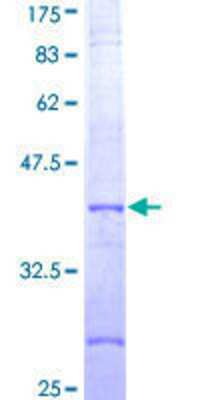Recombinant Human NLRP3/NALP3 GST (N-Term) Protein
Novus Biologicals, part of Bio-Techne | Catalog # H00114548-Q01

Key Product Details
Source
Wheat germ
Tag
GST (N-Term)
Conjugate
Unconjugated
Applications
ELISA, Affinity Purification, Microarray, Western Blot
Product Specifications
Description
A recombinant protein with a N-terminal GST tag corresponding to the amino acid sequence 1-100 of Human NLRP3/NALP3
Source: Wheat Germ (in vitro)
Amino Acid Sequence: MKMASTRCKLARYLEDLEDVDLKKFKMHLEDYPPQKGCIPLPRGQTEKADHVDLATLMIDFNGEEKAWAMAVWIFAAINRRDLYEKAKRDEPKWGSDNAR
Purity
>80% by SDS-PAGE and Coomassie blue staining
Predicted Molecular Mass
36.74 kDa.
Disclaimer note: The observed molecular weight of the protein may vary from the listed predicted molecular weight due to post translational modifications, post translation cleavages, relative charges, and other experimental factors.
Disclaimer note: The observed molecular weight of the protein may vary from the listed predicted molecular weight due to post translational modifications, post translation cleavages, relative charges, and other experimental factors.
Activity
This protein was produced in an in vitro wheat germ expression system that should preserve correct conformational folding that is necessary for biological function. While it is possible that this protein could display some level of activity, the functionality of this protein has not been explicitly measured or validated.
Protein / Peptide Type
Recombinant Protein
Scientific Data Images for Recombinant Human NLRP3/NALP3 GST (N-Term) Protein
Recombinant Human NLRP3/NALP3 Protein [H00114548-Q01] - 12.5% SDS-PAGE Stained with Coomassie Blue.
Formulation, Preparation and Storage
H00114548-Q01
| Preparation Method | in vitro wheat germ expression system |
| Formulation | 50 mM Tris-HCI, 10 mM reduced Glutathione, pH 8.0 in the elution buffer. |
| Preservative | No Preservative |
| Concentration | Please see the vial label for concentration. If unlisted please contact technical services. |
| Shipping | The product is shipped with dry ice or equivalent. Upon receipt, store it immediately at the temperature recommended below. |
| Stability & Storage | Store at -80C. Avoid freeze-thaw cycles. |
Background: NLRP3/NALP3
NLRP3 is expressed in a variety of cell types such as monocytes, dendritic cells, lymphocytes and epithelial cells (3). Abnormal NLRP3 activation may occur as the result of inherited mutations and is associated with diseases such as hereditary periodic fevers (HPFs) and familial cold autoinflammatory syndrome (FCAS). Additionally, abnormal NLRP3 activation is associated with a variety of diseases such as gout, obesity, atherosclerosis, Alzheimers, multiple sclerosis and type 2 diabetes (1, 3). NLRP3 inflammasome is regulated by several post-translational modifications (e.g., ubiquitination, phosphorylation and sumoylation) as well as by various interacting proteins (e.g., JNK1, FBXO3, TXNIP, MARK4 and PKD) (4).
References
1. Abderrazak, A., Syrovets, T., Couchie, D., El Hadri, K., Friguet, B., Simmet, T., & Rouis, M. (2015). NLRP3 inflammasome: From a danger signal sensor to a regulatory node of oxidative stress and inflammatory diseases. Redox Biology. https://doi.org/10.1016/j.redox.2015.01.008
2. Yang, Y., Wang, H., Kouadir, M., Song, H., & Shi, F. (2019). Recent advances in the mechanisms of NLRP3 inflammasome activation and its inhibitors. Cell Death and Disease. https://doi.org/10.1038/s41419-019-1413-8
3. Zahid, A., Li, B., Kombe, A. J. K., Jin, T., & Tao, J. (2019). Pharmacological inhibitors of the nlrp3 inflammasome. Frontiers in Immunology. https://doi.org/10.3389/fimmu.2019.02538
4. Kelley, N., Jeltema, D., Duan, Y., & He, Y. (2019). The NLRP3 inflammasome: An overview of mechanisms of activation and regulation. International Journal of Molecular Sciences. https://doi.org/10.3390/ijms20133328
Long Name
NLR Family, Pyrin Domain Containing 2
Alternate Names
AGTAVPRL, AII, CIAS1, Cryopyrin, FCAS, FCU, MWS, NACHT, NALP3, PYPAF1
Gene Symbol
NLRP3
Additional NLRP3/NALP3 Products
Product Documents for Recombinant Human NLRP3/NALP3 GST (N-Term) Protein
Product Specific Notices for Recombinant Human NLRP3/NALP3 GST (N-Term) Protein
This product is produced by and distributed for Abnova, a company based in Taiwan.
This product is for research use only and is not approved for use in humans or in clinical diagnosis. This product is guaranteed for 1 year from date of receipt.
